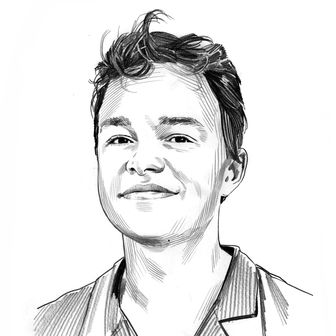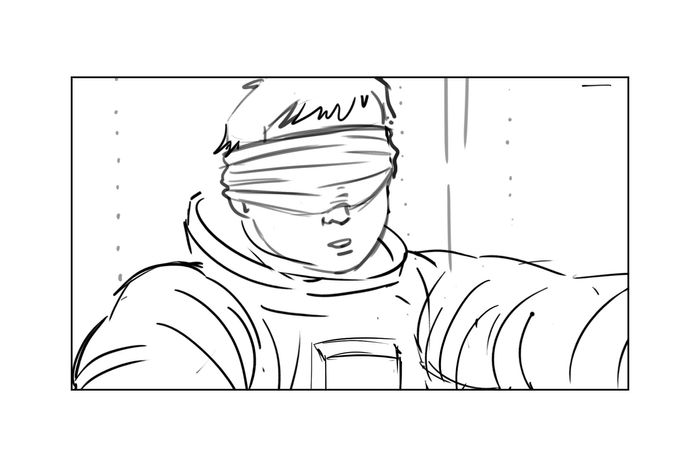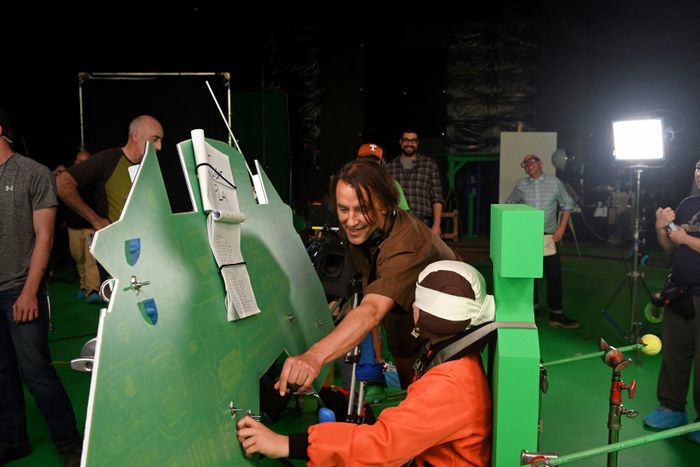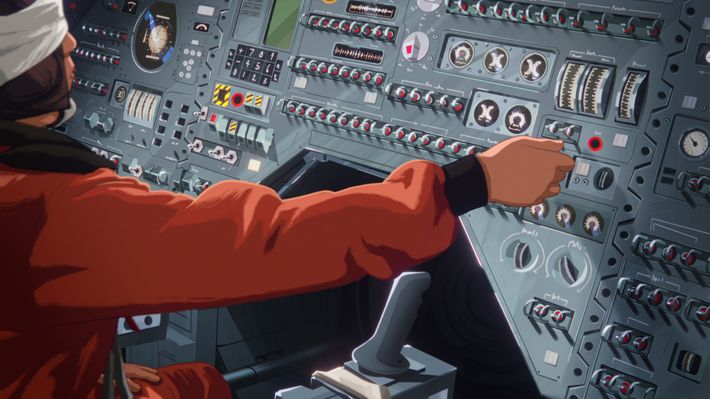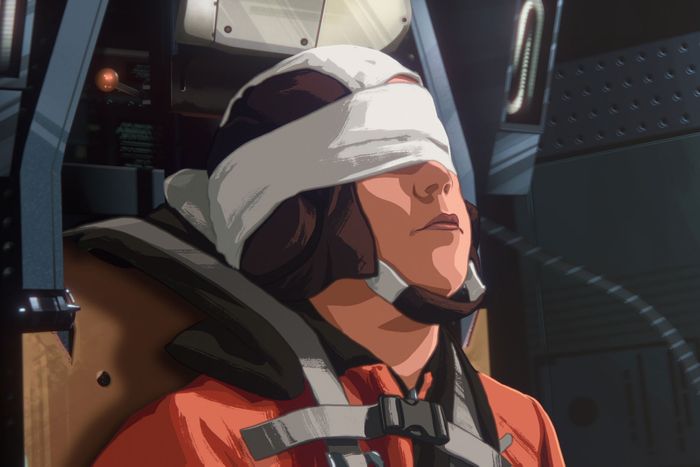
Every once in a while, Richard Linklater gets stuck on an idea for a movie that he can’t quite imagine filming in live action. In 1998, he had all but given up on one such idea when his longtime friend and collaborator Tommy Pallotta showed the filmmaker what his roommate Bob Sabiston was working on. An animator and software engineer, Sabiston had developed a program to speed up the process of rotoscoping — an animation technique that involves tracing over live-action footage frame by frame. Linklater’s idea found its medium, and it eventually became his first animated film, 2001’s Waking Life, a plotless exploration of lucid dreaming. Captivated by the rotoscoping technique, Linklater turned to Pallotta and Sabiston again for 2006’s A Scanner Darkly — a trippy Philip K. Dick adaptation that uses animation to immerse the audience in the characters’ drug-induced paranoia.
Sixteen years removed from Scanner, Linklater has returned to animation with Apollo 10½: A Space Age Childhood (out now on Netflix), a movie that finds the Boyhood filmmaker on familiar ground in more ways than one. Set in Houston, Texas, in 1969, it depicts the moon landing through the eyes of Stan (Milo Coy), a fourth-grader who fantasizes about landing on the moon himself. Framed by narration from an adult Stan (Jack Black), the movie uses animation to explore the subjectivity of memory — to pull the audience into what Linklater has called a “memory state.”
When he first realized the long-gestating movie should be animated, Linklater called up Pallotta, and they devised a hybrid animation approach that incorporates some rotoscoping but relies more on traditional 2-D and 3-D animation techniques than their prior collaborations had. After shooting for 20 days on a green-screen stage in Austin in early 2020, Linklater and Pallotta spent the next 21 months overseeing the animation process, which was split between a local team in Austin and another in Amsterdam. The pair spoke with Vulture about their unique process, analog memories, and bringing ’60s Houston to life through animation.
It’s been 16 years now since A Scanner Darkly. When did you guys have your first conversation about working on this movie? And how did that go?
Pallotta: Rick and I are friends in life. When we’re not making movies, we still talk to each other. And he always has a bunch of different projects in his mind. I don’t know — how long has this been percolating? It’s been years.
Linklater: The first initial thought was, like, 2004. But I don’t think I even started making real moves till about 2012.
Pallotta: Rick and I lived briefly in the same sort of suburb in the shadow of NASA. So when he was talking about growing up around NASA and that whole era, of course, I was foaming at the mouth, but I’m not presumptuous enough to think, Oh, well this is going to be that. I know that he has to work it through in his mind. But then it was really not a long time before we started preproduction. When Rick said, “Hey, what do you think about it animated?” I was like, “Yes, let’s go.” I think the first thing I said was: “Why did it take you so long to ask?”
Linklater: It had been a long time. We were doing a lot of research, and I had been funding some prep, but I didn’t have the animated idea for a while. About ten years ago, Tommy and I had developed an animated film that didn’t happen. That, to us, was an evolutionary step beyond Scanner. We had some R&D money that I thought we put to pretty good use on another film. And then this story — once I jumped to animation, I immediately talked to Tommy, and he was like, “Yeah. Let’s do it.”
That was the Incredible Mr. Limpet remake you were working on?
Linklater: Yeah, with Zach Galifianakis. It would’ve been fun. It was kind of an ecological angle on that story.
What new techniques were you working on that you ended up using on this film?
Pallotta: I was doing a lot more in 3-D, and we were exploring looks, but we also explored a sort of expressionistic approach to it, a more painterly approach. We started talking about old Disney movies and the aesthetic and how to bring that into the 3-D world.
There were a lot of older 2-D artists and animators around that were looking for work. We started working with all these older people who had been in the business, and they were doing 2-D thumbnails and sketches for us. The idea of mixing the 2-D and 3-D and rotoscope — it seemed like a hybrid approach was interesting.
There’s a very strict, unspoken rule that if you’re going to do something that’s going to be 3-D, this is the production design all the way through. There’s a practical reason for that. A hybrid approach is difficult to do — you’d have to have a separate pipeline and workflow for every single technique. But we sparked at that moment when we started mixing different elements. We didn’t want to repeat Scanner Darkly.
Linklater: No. I felt we took that about as far as it could go.
Scanner Darkly sounds like it had a pretty complicated animation process. Were there any technology advancements that alleviated concerns that this movie would be a similarly difficult undertaking?
Linklater: When you’re doing something new that hasn’t been done, you’re inventing. But this went so much smoother. I guess, our communication and so much else had been worked out. Even though it felt like we were having to invent things as we went and fit them in, I was very confident in the team. I knew they could figure everything out, because we put so much forethought into it.
If I looked up on set, and Matthijs Joor and Tommy were looking at me, going, “Ooh, that will be very problematic,” I’m like, “Okay. Let’s not do that.” It’s a practical exchange about everything — camera movement or whatever you’re doing. But I was really confident in the technique, because it had advanced to the point that what we were going to bring to it was more ideas than technology. The technology wasn’t the bugaboo — it was just trying to get our ideas rendered properly, you know?
Pallotta: We went backward in many ways. We wanted something that felt timeless and evergreen, and we wanted to lean on creativity over technology. So it wasn’t about the latest software. In fact, this was basically built on TVPaint. So a 2-D, 2.5-D animation package that anybody can use — there’s no proprietary software. And it’s really done in an old-school, 2-D way, where you basically create key frames and you do in-betweens.
Even down to the fact that this is done on twos. It’s 12 frames per second — a step back from Scanner, which was 24. And Scanner used interpolation for the rotoscope. So you would draw a line, and the computer filled it in. We didn’t do any of that on this. We really looked at the older 2-D-animation methods and relied on the creativity and the brute force of people’s hands doing the work.
Linklater: We were obsessed with the fact that we’re making a period piece. Every creative decision had to fit with the look of what we were going for —whether it was the color palette, just the whole texture of it, the vibe. So it was whatever would contribute to that.
The movie features so much ’60s cultural ephemera — from NASA technology to all the TV shows referenced throughout. But it’s also a memory piece, which seems like it determined a lot of the design choices. How did you balance the realism of capturing that period with the subjectivity of it being from a kid’s perspective?
Linklater: Well, all these worlds have to exist simultaneously. They all have slightly different color palettes and different styles, and yet it needed to flow as one piece. But, I think, within the memory is where it flowed — the creative space in your brain where fantasies mingle with memories.
Pallotta: Story and character — that arc was always the main driver. One real advantage that we had on this is that we didn’t have it all figured out when we went into production. Most animation is very meticulously planned, and, by the time you’re going into production, there’s very little room for any deviation from what that plan is. We created a pipeline in the workflow that allowed us to have that room to play and experiment, to fail, and to find out what works. And having someone like Rick, who has a grand vision for the entire story, helps in that it kept it on the rails the entire time.
Did that spontaneity allow the actors to improvise at all? Was anything just made up on the fly?
Linklater: It’s really hard to improvise in the right language of the year — especially if it’s an era before you were born. Kids improvising doesn’t work, because they reference things that aren’t accurate. We had a lot of rehearsal time, which was kind of like playtime. That was fun. It’s a loose set. Almost like filming rehearsals — we could try all kinds of things. But, I guess, “improv” isn’t exactly the word.
Bill Wise is a very spontaneous performer and kind of a genius in that regard. But, even then, every shot in this was a special effect. It was all this looseness hemmed into an exact design. So we weren’t that free, and yet we felt very free. If you talk to a kid who acted in this, they’re like, “Yeah, we just did whatever we wanted.”
You worked on the Astroworld sequence for something like nine months. What was so important about capturing that specific ride, the Alpine Sleigh Ride, and what were the animation challenges there?Linklater: Oh God. It was all fun. Nothing was brutal or a problem problem but a challenge for sure. That ride’s really complex, and we were creating kind of in a vacuum. That just becomes the communication challenge of animation. We have limited visual reference. A lot of it is you’re just trying to describe and feel your way through that. It was very demanding, because it’s a lot of different things at once.
Pallotta: If you grew up in Houston during that era, Astroworld was the best thing in the world. So there’s a lot of reverence and desire to revisit that — it’s gone now. But, again, we were relying on our memories. Rick has a fantastic memory. I misremember what happened yesterday. We really searched everywhere to find information about it, and it was very difficult. So a lot of that really was our memory.
Linklater: You’re going, “No, I remember this.” And it’s funny to be communicating that to Amsterdam — people in another culture. Even things like baseball they don’t understand. You have to just give context and reasons for everything. It’s saying, “No, there’s a difference between a right-fielder and a second-baseman. We gotta get that kid back,” and you realize you’re speaking Greek to them.
That’s why I rely on Tommy to translate some of my exactitude to them. But everyone bought into the central concept of: There is a right answer to everything, and we’re going for that. It’s all important, and we’re trying to get it as exact as possible. So the bar was pretty high on every shot in the movie.
You put out an open call five years ago or so in Houston for people to share photos and home videos that they had from that era. Were there any real treasures you ended up incorporating into the movie?
Linklater: We did an open call, because we were looking for these reference points to see what the record was like for things that didn’t exist anymore — like Astroworld. Fortunately, a lot of people took their Super 8 cameras to Astroworld in those days. People gave us their home movies. So constant archive research. Many years of that but it paid off. We had a huge bible of it.
Pallotta: And we took cues from the texture of the media. So we took the grainy, imperfect Super-8 clips and tried to create an animation equivalent of that.
Linklater: It was like, Let’s keep that rougher documentary archive feel to it. You don’t see that a lot in animation. But on this it felt like, That’s how we experienced it, you know? Scratchy newsreel footage or home movies: That’s how you took in the culture around you — off a little TV or whatever. We were trying to capture the visual essence of what it felt like.
Were there any archival clips you hoped to use but just couldn’t get cleared or find the right version of?
Linklater: Not really. We ended up cutting out a lot. There was an overabundance of, like, Saturday-morning cartoons, Houston wrestling. The four-hour version of this movie is pretty great. You’ve got Kurt Vonnegut giving a long interview — kind of shitting all over the NASA program from that very day. There’s a lot of great stuff when you start delving into the archive.
Pallotta: One of the biggest challenges of the archive was the Apollo 11 footage — the walking on the moon. In my memory, the footage is very clear, but all that we could find of it was so low resolution and almost indistinguishable. Then, to recreate that in animation was difficult, because animation makes everything so clear and distinct.
In revisiting old footage, did you realize that you had misremembered or misunderstood anything about it?
Linklater: It was fun to delve back into a specific moment in history that you do remember as an experience and to see it from an adult perspective. That’s really the dialogue of the movie. The critique element of it is there.
Pallotta: There were discussions about when to lean into the hope and the optimism of that time and maybe not represent it so completely. We had a big debate about Galveston Beach, which looks very beautiful in our movie. We were like, “Do we make the water blue or brown — like it really is? Do you have all the trash on the beach?” Every single scene, that was sort of the debate: Is it the idealized version of it, or is it the realistic version of it?
The movie shows how kids in the ’60s were constantly in danger — even if they didn’t really think of it at the time. I thought the funniest moment was when the kids are playing Red Rover and that kid gets a compound fracture. It’s just hilariously brutal.
Linklater: That’s what childhood felt like at that time. It was just danger everywhere. Anything could end in some kind of accident. I mean, it’s always like that, but you were really unsupervised. You could screw up royally at any moment.
Pallotta: We’re still here, you know?
Linklater: Yeah. We survived.
With things like that arm-breaking moment, does the animation help you heighten the intensity in a way? If you show that in live action, it might not be as jarring.
Linklater: Yeah, with the animation, you can go for it. We were always like, “Ooh, is that too much?” It’s like, no, let’s get to the point here. A little hyperbole is okay. Or visual hyperbole. We’re telling a story. Whatever heightens that was within our limits, you know?
And yet, a lot of the outdoor scenes appear as if they were filmed at golden hour, which bathes the movie in a warm, nostalgic feeling.
Linklater: That is the after-school vibe. Our Kodachrome-40 era.
Tommy Pallotta: If it’s the middle of summer in Texas, you have a really strong overhead light that’s very unflattering and hurts to be in. So there’s a little bit of idealization to it — but it is that moment, that magic hour, seeing those things through those rose-colored glasses. You don’t really remember the blinding light that’s oppressive; you remember just being out — playing and fun and free.
This interview has been edited and condensed for clarity.


